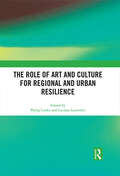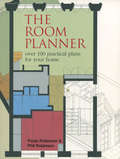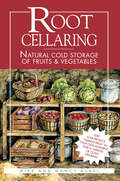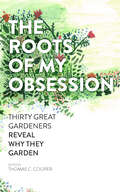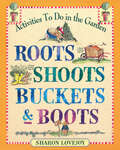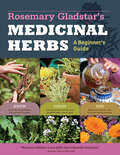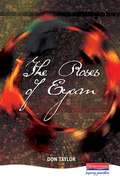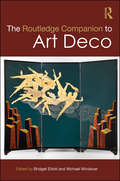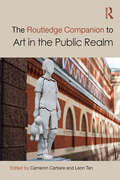- Table View
- List View
The Role of Art and Culture for Regional and Urban Resilience
by Philip Cooke Luciana LazzerettiThis book analyses the influence of art and culture as an engine to promote the resilience of regional and urban economies. Under a multidiscplinary perspective, the book examines the contribution of some creative regions and cities as places in which processes of transformation, innovation and growth are activated in response to external pressures. Through different theoretical frameworks and empirical investigations and suggesting a critical discussion of the notion of resilience, the authors argue that cultural and creative resources may offer a sustainable model in order to afford different typologies of shocks. The book will appeal scholars of regional and urban science and cultural and creative economies and will open up a number of considerations for policy makers.This volume was originally published as a special issue of European Planning Studies.
The Role of Art and Culture for Regional and Urban Resilience
by Philip Cooke Luciana LazzerettiThis book analyses the influence of art and culture as an engine to promote the resilience of regional and urban economies. Under a multidiscplinary perspective, the book examines the contribution of some creative regions and cities as places in which processes of transformation, innovation and growth are activated in response to external pressures. Through different theoretical frameworks and empirical investigations and suggesting a critical discussion of the notion of resilience, the authors argue that cultural and creative resources may offer a sustainable model in order to afford different typologies of shocks. The book will appeal scholars of regional and urban science and cultural and creative economies and will open up a number of considerations for policy makers.This volume was originally published as a special issue of European Planning Studies.
The Roman Garden: Space, Sense, and Society (Routledge Monographs in Classical Studies)
by Katharine T. von StackelbergThis innovative book is the first comprehensive study of ancient Roman gardens to combine literary and archaeological evidence with contemporary space theory. It applies a variety of interdisciplinary methods including access analysis, literary and gender theory to offer a critical framework for interpreting Roman gardens as physical sites and representations. The Roman Garden: Space, Sense, and Society examines how the garden functioned as a conceptual, sensual and physical space in Roman society, and its use as a vehicle of cultural communication. Readers will learn not only about the content and development of the Roman garden, but also how they promoted memories and experiences. It includes a detailed original analysis of garden terminology and concludes with three case studies on the House of Octavius Quartio and the House of the Menander in Pompeii, Pliny’s Tuscan garden, and Caligula’s Horti Lamiani in Rome. Providing both an introduction and an advanced analysis, this is a valuable and original addition to the growing scholarship in ancient gardens and will complement courses on Roman history, landscape archaeology and environmental history.
The Roman Garden: Space, Sense, and Society (Routledge Monographs in Classical Studies)
by Katharine T. von StackelbergThis innovative book is the first comprehensive study of ancient Roman gardens to combine literary and archaeological evidence with contemporary space theory. It applies a variety of interdisciplinary methods including access analysis, literary and gender theory to offer a critical framework for interpreting Roman gardens as physical sites and representations. The Roman Garden: Space, Sense, and Society examines how the garden functioned as a conceptual, sensual and physical space in Roman society, and its use as a vehicle of cultural communication. Readers will learn not only about the content and development of the Roman garden, but also how they promoted memories and experiences. It includes a detailed original analysis of garden terminology and concludes with three case studies on the House of Octavius Quartio and the House of the Menander in Pompeii, Pliny’s Tuscan garden, and Caligula’s Horti Lamiani in Rome. Providing both an introduction and an advanced analysis, this is a valuable and original addition to the growing scholarship in ancient gardens and will complement courses on Roman history, landscape archaeology and environmental history.
The Romantic Minimalist: Simple Homes with Soul
by Atlanta Bartlett Dave Coote'Atlanta and Dave's unique blend of nostalgic romanticism combined with a thoughtful approach to sustainability and slow living, makes this book a dream for anyone interested in how to live with vintage and antiques without succumbing to clutter or consumerism.'Paula Sutton - Hill House Vintage'A book for those who fall between the all-out riot that is maximalism and the rigidity of minimalism, the authors lead you gently down a middle path where it's about layering textures to create comfort and character without overwhelming the senses. If there is such a thing as mindful decorating this is it.' Kate Watson-Smyth - Mad About the House'Atlanta and Dave have a unique talent to build, rework and decorate properties with a functional and romantic flow. Using reclaimed and authentic elements is a signature of their work and creates charming and timeless homes.' Rachel Ashwell - Founder of Shabby Chic'Atlanta and Dave prove that their beautiful beachy aesthetic is easy to achieve in this stylish book, which is a celebration of pared back, timeless interiors. I'd love to live in every one.' Sarah Tomczak - Editor in Chief Red Magazine'I have admired Atlanta and Dave for many years! They stand as a true trailblazers in British vintage interiors. Her aesthetic exudes a sense of timeless beauty and sophistication.' Pearl LoweIn this timely interiors book, design duo Atlanta Bartlett and Dave Coote explore a new type of minimalism. The emphasis is on appreciating the imperfect, encouraging self-expression and never compromising on comfort.This new minimalism has romance and nostalgia at its heart. It celebrates the plain and simple things in life; loves old, time-worn treasures; shuns materialism in favour of sustainability and creates a home to soothe the soul. The book includes stunningly photographed case studies of homes, alongside chapters on topics ranging from working with colour and textiles, to sustainability and sourcing found objects from nature. This is the perfect manual for curating elegant and soothing living spaces.
Romany caravan (Large Print)
This image shows the side view of a painted Romany caravan. There is a locator dot shown, which will be at the top left of the page when the image is the right way up. At the lower left of the image, four steps lead up to a door at the rear end of the caravan, which is not visible in this image. To the right of the steps at the bottom of the image, two of the caravan's four spoked wheels can be seen with the larger on the left. Above the small wheel on the right is the supporting frame upon which the axle turns. The axle cannot be shown. Above the wheels, decorative columns are shown on the panelling of the caravan, leading up to two windows with open shutters. The painted wooden roof sticks out beyond the body of the caravan at the top of the image, particularly at the back.
Romany caravan (UEB Contracted)
This image shows the side view of a painted Romany caravan. There is a locator dot shown, which will be at the top left of the page when the image is the right way up. At the lower left of the image, four steps lead up to a door at the rear end of the caravan, which is not visible in this image. To the right of the steps at the bottom of the image, two of the caravan's four spoked wheels can be seen with the larger on the left. Above the small wheel on the right is the supporting frame upon which the axle turns. The axle cannot be shown. Above the wheels, decorative columns are shown on the panelling of the caravan, leading up to two windows with open shutters. The painted wooden roof sticks out beyond the body of the caravan at the top of the image, particularly at the back.
Romany caravan (UEB uncontracted)
This image shows the side view of a painted Romany caravan. There is a locator dot shown, which will be at the top left of the page when the image is the right way up. At the lower left of the image, four steps lead up to a door at the rear end of the caravan, which is not visible in this image. To the right of the steps at the bottom of the image, two of the caravan's four spoked wheels can be seen with the larger on the left. Above the small wheel on the right is the supporting frame upon which the axle turns. The axle cannot be shown. Above the wheels, decorative columns are shown on the panelling of the caravan, leading up to two windows with open shutters. The painted wooden roof sticks out beyond the body of the caravan at the top of the image, particularly at the back.
Room Acoustics
by Heinrich KuttruffWell established as a classic reference and specialised textbook, since its first publication in 1973, Heinrich Kuttruff’s Room Acoustics combines detailed coverage with a state of art presentation of the theory and practice of sound behaviour in closed spaces. This sixth edition presents several additional new sections, for instance on the reflection of a spherical wave from a wall, on finite element methods for sound field calculation and on virtual reality, as well as giving an overhaul of the standard material. Particular emphasis is given to the properties and calculation of reverberation, the most obvious acoustical feature of a room. And further key topics include the various mechanisms of sound absorption and their practical application as well as scattering by wall irregularities including pseudo-stochastic structures. Extensive space is given to of psychoacoustic insights and the quality criteria derived from them, along with new procedures for the sensory assessment of concert hall acoustics. As in earlier editions, one full and updated chapter is devoted to the design and performance of electroacoustic systems which nowadays is not just a method for sound amplification but offers many possibilities for correcting acoustic deficiencies and modifying a hall’s natural acoustics.
The Room Planner: Over 100 practical plans for your home
by Paula Robinson Phil RobinsonMost of us want to improve our homes and to increase their value at the same time, but very few of us have the money to spend on a professional architect. In Room Planner designer Paula Robinson gives you all the ideas and practical information you need to adapt the space in which you live. The book features over 100 clear, colour-coded plans allowing you to pick and choose layouts and designs according to what's appropriate for your home, whether you have a bedsit or a five-bedroom house. To reflect changing lifestyles, the emphasis is very much on versatility and flexibility, with chapters on High-performance space (making maximum use of available space), Valuable space (dividing space to create additional rooms and increase property value), Flexible space (creating moveable partitions) and Individual space (innovative solutions for particular rooms). There's also basic advice and tips, including: Using colour in the home: blue helps to focus the mind and intellect; green has harmonious, soothing effects; yellow stimulates and invigorates; orange stimulates the appetite.Using shapes: the kidney shape brings a softness and flexibility to interiors; circles introduce a sense of freedom and space.Creating atmosphere: an inset fire set higher up in the wall can have a stunning effect; backlit cupboard doors draw the eye; concealed lighting introduces mood and atmosphere while creating a sense of depth; mirroring the wall opposite the entrance door can bring life and character to a property.This is an essential manual not only for homeowners seeking to rethink their living space, but also for those who are building their home from scratch. Paula and Phil's guide will inspire in you the confidence and enthusiasm to maximise the potential of your living space, so that you too can create your dream home.
Root Cellaring: Natural Cold Storage of Fruits & Vegetables
by Mike Bubel Nancy BubelDiscover how easy it can be to turn some extra space in your basement, garage, or even your closet into your very own root cellar.
Rootbound: Rewilding a Life
by Alice Vincent'Breathtakingly beautiful' i 'Tender and wholehearted' Helen Jukes LONGLISTED FOR THE WAINWRIGHT PRIZE A BEST BOOK OF THE YEAR IN FINANCIAL TIMES AND I When she suddenly finds herself uprooted, heartbroken, grieving and living out of a suitcase in her late twenties, Alice Vincent begins planting seeds. She nurtures pot plants and vines on windowsills and draining boards, filling her many temporary London homes with green. As the months pass, and with each unfurling petal and budding leaf, she begins to come back to life. Mixing memoir, botanical history and biography, Rootbound examines how bringing a little bit of the outside in can help us find our feet in a world spinning far too fast.
The Roots of My Obsession: Thirty Great Gardeners Reveal Why They Garden
by Thomas C. CooperWhy would any sane person spend hours on hands and knees, courting aching joints and a ruined back, just to raise a bunch of plants? A rich, complex, and human answer can be found in the pages of The Roots of My Obsession.
Roots, Shoots, Buckets & Boots: Gardening Together with Children
by Sharon LovejoyRoots, Shoots, Buckets & Boots features 12 spirited, easy-to-implement ideas for theme gardens that parents and kids can grow together.
Rose (Large Print)
by Rnib BookshareThere are two views of a rose, a front view on the left and a side view on the right of the page. There is a locator dot shown, which will be at the top left of the page when the image is the right way up. The front view shows the deep pink-red rose flower head with many petals arranged in swirls. These are packed more tightly towards the centre of the flower. Down from the flower head, the stem runs down the page. Halfway down the stem there is a side branch with five leaves. The stem also has five sharp thorns. The side view shows the flower head to the left and a short piece of stem to the right with two thorns. Each flower head is approximately eight centimetres in diameter. There are two types of rose. A bush rose usually grows to a height of about a metre, depending on how much it is pruned. A climbing rose can grow many metres up a wall or fence.
Rose (UEB Contracted)
by Rnib BookshareThere are two views of a rose, a front view on the left and a side view on the right of the page. There is a locator dot shown, which will be at the top left of the page when the image is the right way up. The front view shows the deep pink-red rose flower head with many petals arranged in swirls. These are packed more tightly towards the centre of the flower. Down from the flower head, the stem runs down the page. Halfway down the stem there is a side branch with five leaves. The stem also has five sharp thorns. The side view shows the flower head to the left and a short piece of stem to the right with two thorns. Each flower head is approximately eight centimetres in diameter. There are two types of rose. A bush rose usually grows to a height of about a metre, depending on how much it is pruned. A climbing rose can grow many metres up a wall or fence.
Rose (UEB Uncontracted)
by Rnib BookshareThere are two views of a rose, a front view on the left and a side view on the right of the page. There is a locator dot shown, which will be at the top left of the page when the image is the right way up. The front view shows the deep pink-red rose flower head with many petals arranged in swirls. These are packed more tightly towards the centre of the flower. Down from the flower head, the stem runs down the page. Halfway down the stem there is a side branch with five leaves. The stem also has five sharp thorns. The side view shows the flower head to the left and a short piece of stem to the right with two thorns. Each flower head is approximately eight centimetres in diameter. There are two types of rose. A bush rose usually grows to a height of about a metre, depending on how much it is pruned. A climbing rose can grow many metres up a wall or fence.
Rosemary Gladstar's Medicinal Herbs: 33 Healing Herbs to Know, Grow, and Use
by Rosemary GladstarWith this bestselling book by Rosemary Gladstar, the godmother of modern herbalism, learn how to grow, harvest, prepare, and use the 33 most common and versatile healing plants. Everyone will love this guide to inexpensive and natural home-healing!
Roses Love Garlic: Companion Planting and Other Secrets of Flowers
by Louise RiotteFrom deterring insect pests with hot peppers to encouraging strawberries by bordering them with chrysanthemums, Louise Riotte shows you how to use the natural qualities of common plants to increase your garden&’s productivity. Roses Love Garlic profiles hundreds of plants, features sample garden designs, and includes recipes for using your harvest to make herbal cosmetics, medicinal mixtures, and plant-based dyes. You&’ll enjoy learning about the fascinating ways plants work together as you tend to a thriving and bountiful garden. This publication conforms to the EPUB Accessibility specification at WCAG 2.0 Level AA.
Roses Of Eyam (PDF)
by Butterworth-Heinemann Staff Don TaylorThis series of plays for the 11-16 age range offers contemporary drama and new editions of classic plays. The series has been developed to support classroom teaching and to meet the requirements of the National Curriculum Key Stages 3 and 4.
Roses Without Chemicals: 150 Disease-Free Varieties That Will Change the Way You Grow Roses
by Peter E. KukielskiWith this guide in hand, you can finally choose the right rose from the start and successfully grow them in an organic and sustainable way.
The Routledge Companion to Art Deco (Routledge Art History and Visual Studies Companions)
by Bridget Elliott Michael WindoverScholarly interest in Art Deco has grown rapidly over the past fifty years, spanning different academic disciplines. This volume provides a guide to the current state of the field of Art Deco research by highlighting past accomplishments and promising new directions. Chapters are presented in five sections based on key concepts: migration, public culture, fashion, politics, and Art Deco’s afterlife in heritage restoration and new media. The book provides a range of perspectives on and approaches to these issues, as well as to the concept of Art Deco itself. It highlights the slipperiness of Art Deco yet points to its potential to shed new light on the complexities of modernity.
The Routledge Companion to Art Deco (Routledge Art History and Visual Studies Companions)
by Bridget Elliott Michael WindoverScholarly interest in Art Deco has grown rapidly over the past fifty years, spanning different academic disciplines. This volume provides a guide to the current state of the field of Art Deco research by highlighting past accomplishments and promising new directions. Chapters are presented in five sections based on key concepts: migration, public culture, fashion, politics, and Art Deco’s afterlife in heritage restoration and new media. The book provides a range of perspectives on and approaches to these issues, as well as to the concept of Art Deco itself. It highlights the slipperiness of Art Deco yet points to its potential to shed new light on the complexities of modernity.
The Routledge Companion to Art in the Public Realm (Routledge Art History and Visual Studies Companions)
by Cameron CartiereThis multidisciplinary companion offers a comprehensive overview of the global arena of public art.It is organised around four distinct topics: activation, social justice, memory and identity, and ecology, with a final chapter mapping significant works of public and social practice art around the world between 2008 and 2018. The thematic approach brings into view similarities and differences in the recent globalisation of public art practices, while the multidisciplinary emphasis allows for a consideration of the complex outcomes and consequences of such practices, as they engage different disciplines and communities and affect a diversity of audiences beyond the existing 'art world'. The book will highlight an international selection of artist projects that illustrate the themes.This book will be of interest to scholars in contemporary art, art history, urban studies, and museum studies.
The Routledge Companion to Art in the Public Realm (Routledge Art History and Visual Studies Companions)
by Cameron Cartiere Leon TanThis multidisciplinary companion offers a comprehensive overview of the global arena of public art.It is organised around four distinct topics: activation, social justice, memory and identity, and ecology, with a final chapter mapping significant works of public and social practice art around the world between 2008 and 2018. The thematic approach brings into view similarities and differences in the recent globalisation of public art practices, while the multidisciplinary emphasis allows for a consideration of the complex outcomes and consequences of such practices, as they engage different disciplines and communities and affect a diversity of audiences beyond the existing 'art world'. The book will highlight an international selection of artist projects that illustrate the themes.This book will be of interest to scholars in contemporary art, art history, urban studies, and museum studies.
